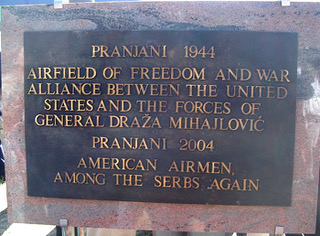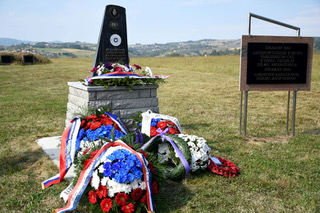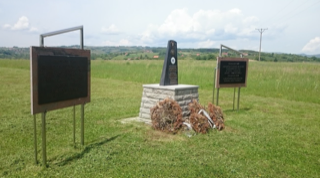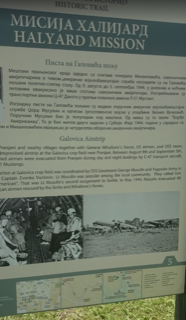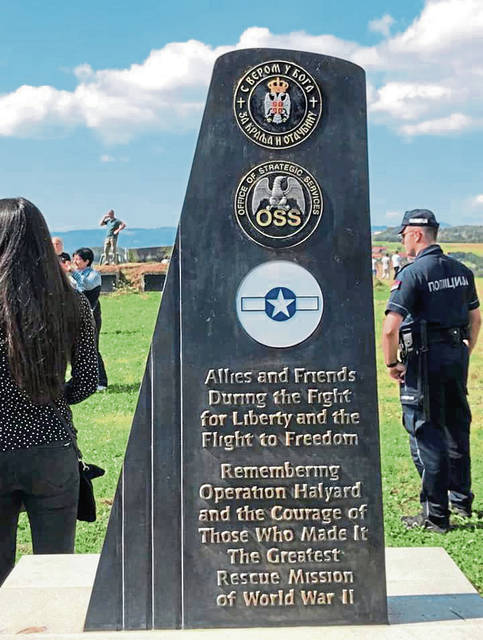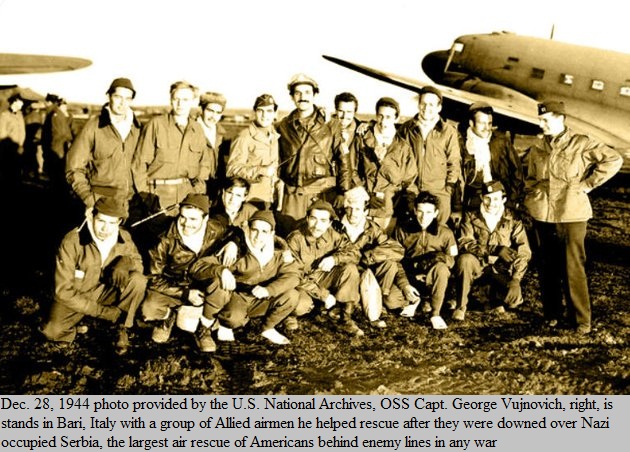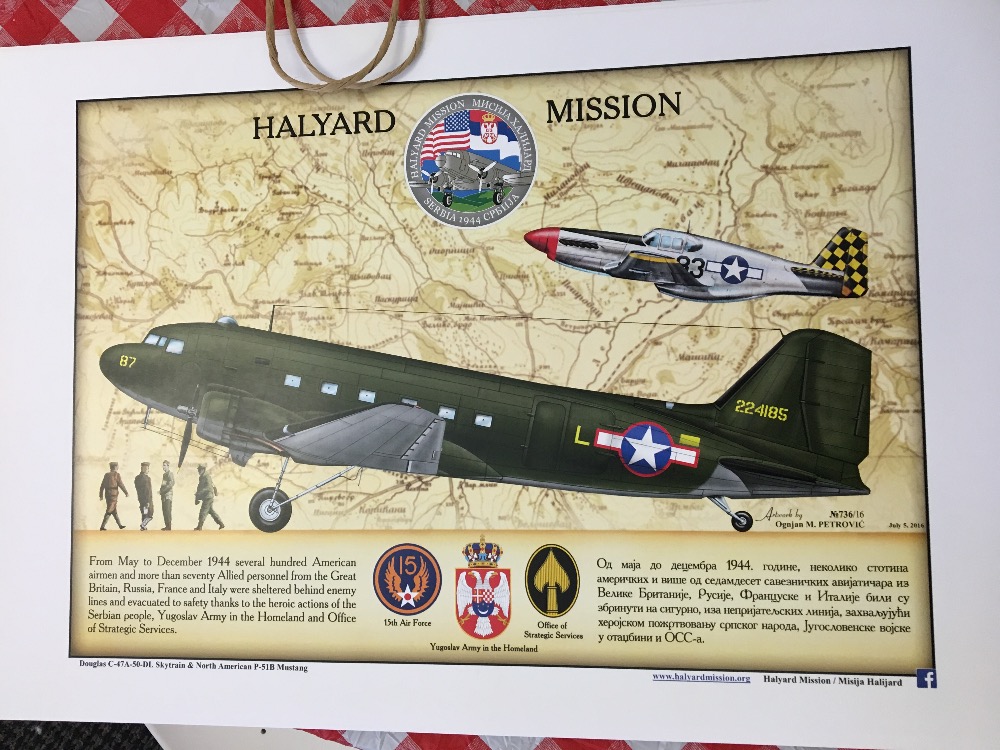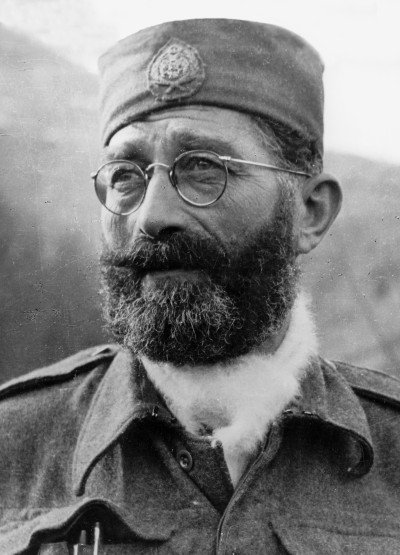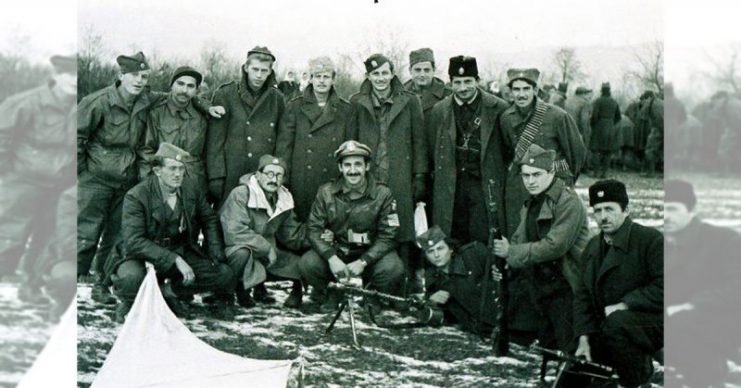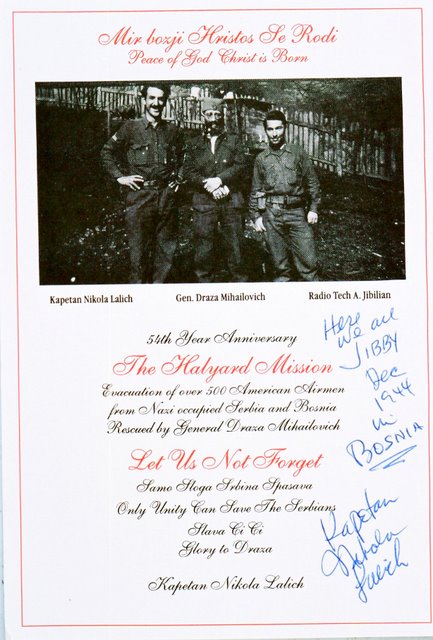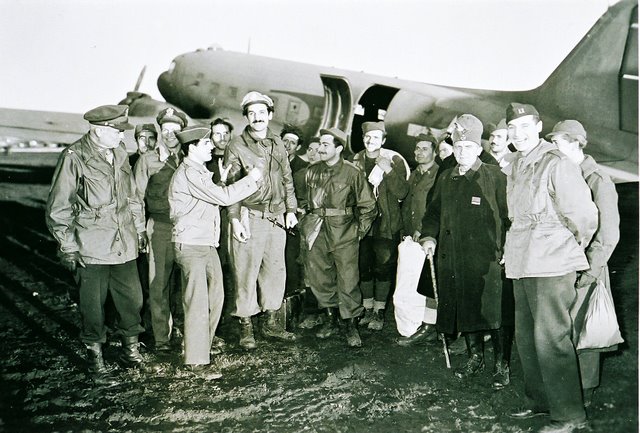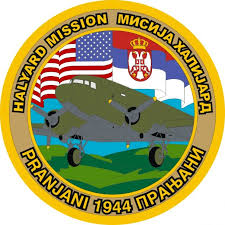Operation Halyard Memorial- Joint US/Serbian Rescue Operation WW2
Details:
In a field on the left side of the road coming from Pranjani (Прањани).
MonumentThe memorial includes a monument which is the shape of an airplane tail on a stone pedestal. Two upright plaques are located adjacent to the monument and several informational panels are located nearby. The memorial is located on the location of the former airfield used during the operation.
Operation Halyard (Godišnjica Operacije Haljard)-was a daring mission to rescue many of the Bomber Aircrews shot down during the raids over south earthen Europe. This article from Special Forces Operations website tells the story:
OPERATION HALYARD, ONE OF THE GREAT RESCUE STORIES OF WWII
by Steve Balestrieri
Feb 28, 2018
Operation Halyard was the greatest rescue mission of American airmen in our history. And it was conducted by a three-man OSS (Office of Strategic Services) team dropped into Serbia that was occupied by the Germans. The OSS operatives linked up with Serbian “Chetniks” led by General Draža Mihailović in August of 1944.
This three-man Halyard team was commanded by Lieutenant George Musulin, along with Master Sergeant Michael Rajacich, and Specialist Arthur Jibilian, the radio operator. The team was assigned to the United States Fifteenth Air Force and designated as the 1st Air Crew Rescue Unit.
By the time the operation was finished, the OSS had rescued 432 American airmen and 80 other Allied personnel who were airlifted out of Yugoslavia and back into Allied control. The story was captured in the outstanding book “The Forgotten 500” by Douglas A. Freeman.
The mission was a daunting one. During WWII, Allied forces stationed in Italy were using airbases there to bomb Germany, as well as Hungary, Slovakia, Croatia, Serbia, Bulgaria, and Romania. Some of the most important targets were sources of petroleum and petroleum refineries in Ploesti, Romania.
The American bomber crews were suffering increasing losses in the Southern theater, and more and more crewmen were bailing out over Yugoslavia. Some were grabbed by German forces or those loyal to the Germans and were made into POWs. But reports were leaking out to OSS men in Italy that hundreds of airmen were falling into the hands of the Serbian people.
The Serbs were risking their lives hiding Allied airmen from the Germans. They shared their meager, insufficient food with the airmen, usually stale bread and goat’s milk. The Serbian women treated the wounded and operated makeshift hospitals as they shuttled the airmen from village to village to hide them from the Germans.
The OSS men had to infiltrate Serbia, make contact with the Chetniks, then the coalition of Americans and Chetniks had to build clandestine airstrips, large enough to hold C-47s all while hiding them from the Germans and land the cargo aircraft and take off without being detected. It was an extremely risky operation, literally, hundreds of things could go wrong.
The Americans had contacted Marshal Tito of the Communist partisans to secure his cooperation. The British considered Yugoslavia as under their sphere of influence, threw their total support behind Tito and were trying to sever all ties with Mihailović, lest they offend Tito and the Communists. They actively tried to rebuff any American attempt to contact Mihailović’s Chetniks.There were rumors, not proved until 1997 that a group of Communist sympathizers inside the British government were poisoning reports of Mihailović’s collaboration with the Germans which submarined any chance of the Chetniks getting any kind of support initially as Churchill and the British were adamantly against any support for them.
Musulin, who had spent nearly a year with the Chetniks was livid at the way the Allies, specifically the British were in essence handing over the country of Yugoslavia to the communists. He asked to be court-martialed so that the true story of the Chetniks and their loyalty to the allied cause would come to light.
However, in truth, the OSS in the Italian theater was full of communist sympathizers, many of whom naively believed because that Russian was an ally that is just fine.
The OSS team was selected and they were ready for infiltration. The overall operation was headed up by OSS agent George Vujnovich. The British were not pleased, especially since the Americans would not be relying on the Brits to ferry them to Yugoslavia nor using British radio operators. It was to be a completely American operation on the ground. Several attempts to infiltrate the team had gone awry with British pilots that had wrong coordinates which intentionally tried to put them over partisan (Tito) territory. Musulin had enough. He demanded an American plane and crew fly the team to Yugoslavia.
The night of August 2nd, the men parachuted into Mihailović’s headquarters at Pranjani. Musulin landed on a chicken coop which sent chickens flying in every direction. Rajacich landed in a tree where Musulin helped him climb down from. Jibilian had the softest landing, coming down in a cornfield. When the Chetniks saw Musulin, they were overjoyed.
One of the American airmen, Richard Felman (415th Bombardment Squadron, 98th Bombardment Group), witnessed the reunion between Musulin and the Chetniks. “The one who was in the lead was the of a mob of Chetniks—they were kissing him and cheering him with tears in their eyes. He was in an American uniform and was one of the biggest chaps I’d ever seen. He walked over to us and put out his hands. ‘I’m George Musulin’, he said.
Musulin was told to expect 150 airmen at the airfield. Secretly, he hoped the number to be exaggerated so as to make it easier to get them all out. But he was surrounded by no less than 250 airmen.
The next morning, the men began work on the airstrip. The two hundred and fifty men were joined by 300 villagers and Chetnik soldiers who provided 60 oxcarts for hauling stones and debris away from the airstrip. The flat terrain was 700 yards long which was the minimum length an airstrip for a C-47 needed to be.
For six days the men toiled on the airstrip using mostly their bare hands with an occasional hoe or pitchfork to clear the ground. The men cleared some trees at the end of the strip to give the C-47s another precious 75 feet of runway. On August 8, Musulin surveyed the airfield and told his radio operator, “Jibby, tell them we’re ready. We’ll start evacuation tomorrow night.”
The next day the men got a scare when a German Stuka dive-bomber accompanied two German JU-52 cargo planes directly over the airstrip. The men, hiding in the woodline, thought that the Germans were there to bomb the freshly cleared airfield. But just as the planes were passing over at 1000 feet, a large herd of cows, sauntered onto the strip giving it the look of a freshly plowed field. The Germans never noticed a thing.
At 10:00 p.m. Musulin heard the drone of the C-47s approaching but they noticed there were four, not six C-47s circling, two had turned back for engine trouble. The first 48 men would be leaving, as they’d load a dozen per plane. As the planes landed and taxied to the sides of the highway, OSS agent Nick Lalich, bounded out to help the team. The Serbs who sheltered the Americans, fed and protected them were happy for their rescue but sad. There were many hugs, tears among both parties that could barely speak a word of each other’s language.
Because of this operation, United States President Harry S. Truman posthumously awarded Mihailović (he’d been arrested by Tito and executed after his takeover) the Legion of Merit for his contribution to the Allied victory during World War II. Initially, this high award and the story of the rescue was classified secret by the U.S. State Department so as not to offend the-then Communist Tito government of Yugoslavia.
The rescue, one of the most daring in U.S. military history and conducted by a handful of OSS men was kept a secret until recently.
The OSS team involved in Operation Halyard included Army Capt. Nick Lalich, Lt. George Musulin, Master Sgt. Michael Rajacich, and Navy Petty Officer 1st Class Arthur Jibilian. Major George Vujnovich was the OSS Operations officer working out of Bair coordinating the entire event.
Monument Text:
Text on the Monument is written in English:
ALLIES AND FRIENDS
DURING THE FIGHT
FOR LIBERTY AND
THE FLIGHT TO FREEDOM
REMEMBERING OPERATION HALYARD
AND THE COURAGE OF
THOSE WHO MADE IT
THE GREATEST
RESCUE MISSION
OF WORLD WAR II
The text on the side plaques are in Serbian and in English. The English reads:
PRANJANI 1944
AIRFIELD OF FREEDOM AND WAR
ALLIANCE BETWEEN THE UNITED
STATES AND THE FORCES IF
GENERAL DRAZA MIHAJLOVIC
PRANJANI 2004
AMERICAN AIRMEN
AMONG THE SERBS AGAIN
Commemorates:
People:
Units:
15th Air Force
1st Air Crew Rescue Unit
325th Fighter Group
60th Troop Carrier Command
Balkan Air Force (BAF)
Chetniks
Office of Strategic Services (OSS)
OSS
Partisans
Wars:
WWII
Battles:
Operation Halyard
Other images :


